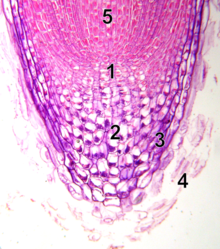植物干细胞:修订间差异
外观
删除的内容 添加的内容
ArthurLau1997(留言 | 贡献) 新条目 |
(没有差异)
|
2018年12月11日 (二) 09:58的版本

植物干细胞是一类存在于植物分生组织中,一类具有自我更新能力和分化潜能的细胞[1][2]。植物干细胞能在植物体受到损伤时分化,修复受损的组织。理论上,植物干细胞同动物的干细胞一样,能进行无限次数的分裂[2][3]。
特性
与动物干细胞类似,植物干细胞具有自我更新和分化的潜能。理论上,植物干细胞能进行无限次的细胞分裂,可认为是不会衰老的细胞[2]。植物干细胞能通过自我更新,始终将自身的数量维持在一定水平,并能在植物体受到损伤时分化成成体细胞,对植物体进行修复[3]。例如,将部分植物的枝条砍断一半,经过一段时间,枝条会发生再生,其原因就是植物干细胞发生了增殖分化[4]。
植物的根尖分生组织、顶芽分生组织,以及维管组织中都存在植物干细胞[5]。分生组织为植物干细胞提供了特殊的微环境,使植物干细胞能保持干性状态[6]。
意义
植物因无法移动,比动物更需要对逆境的抵抗性,植物干细胞的存在,增加了植物的逆境抗性[7]。
参见
参考资料
- ^ Weigel D, Jürgens G. Stem cells that make stems. Nature. February 2002, 415 (6873): 751–4. PMID 11845197. doi:10.1038/415751a (英语).
- ^ 2.0 2.1 2.2 Mirjana Pavlović; Ksenija Radotić. Animal and Plant Stem Cells: Concepts, Propagation and Engineering. Springer. 2017-02-08: 211–212. ISBN 978-3-319-47763-3.
- ^ 3.0 3.1 Scheres B. Stem cells: a plant biology perspective. Cell. August 2005, 122 (4): 499–504. PMID 16145811. doi:10.1016/j.cell.2005.08.006.
- ^ Sonia Trehan; Bozena Michniak-Kohn; Kavita Beri. Plant stem cells in cosmetics: current trends and future directions. Future Sci OA. 2017, 3 (4): FSO226.
- ^ Hirakawa Y, Shinohara H, Kondo Y, Inoue A, Nakanomyo I, Ogawa M, Sawa S, Ohashi-Ito K, Matsubayashi Y, Fukuda H. Non-cell-autonomous control of vascular stem cell fate by a CLE peptide/receptor system. Proceedings of the National Academy of Sciences of the United States of America. September 2008, 105 (39): 15208–13. PMC 2567516
 . PMID 18812507. doi:10.1073/pnas.0808444105.
. PMID 18812507. doi:10.1073/pnas.0808444105.
- ^ Robert Lanza; Robert Paul Lanza. Handbook of Stem Cells. Gulf Professional Publishing. 2004: 629–631. ISBN 978-0-12-436641-1.
- ^ ThomasGreb; Jan U.Lohmann. Plant Stem Cells. Current Biology. 2016-09-12, 26 (17): 816–821.
